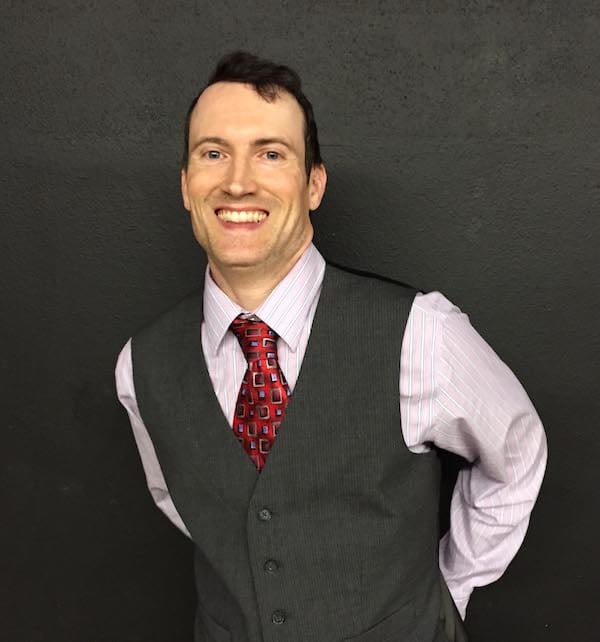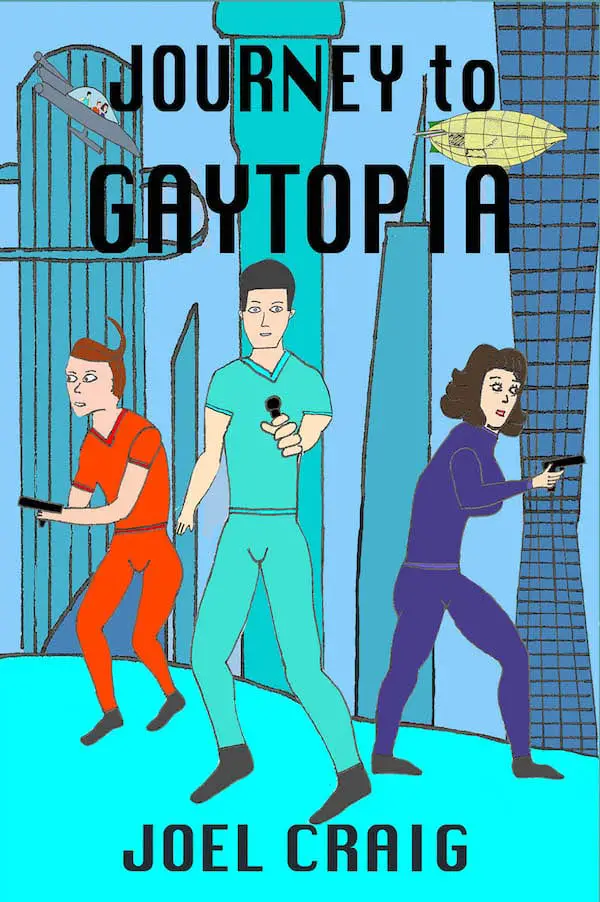 As much as I love reading and watching mainstream media with queer protagonists, I’m even more of a fan of original content from queer creators. No one can tell our stories as well or in as nuanced a way as ourselves, which is where we get gems like Carmilla and The Widow and the Wolf. The goal of my Creator Corner series is so sit down and talk with LGBT+ creators to hear their stories and draw more attention to their art. Needless to say I was thrilled to sit down with actor and creator Joel Craig, author of a new gay science fiction graphic novel, Journey to Gaytopia.
As much as I love reading and watching mainstream media with queer protagonists, I’m even more of a fan of original content from queer creators. No one can tell our stories as well or in as nuanced a way as ourselves, which is where we get gems like Carmilla and The Widow and the Wolf. The goal of my Creator Corner series is so sit down and talk with LGBT+ creators to hear their stories and draw more attention to their art. Needless to say I was thrilled to sit down with actor and creator Joel Craig, author of a new gay science fiction graphic novel, Journey to Gaytopia.
Journey to Gaytopia is the story of broke actors Joel Craig and C. Stephen Foster, who have been cast as series regulars on the “Julianne Moore and Madonna Half-Hour Comedy Show.” But their opportunity to break out as co-stars on the show seems thwarted with Mae Dunaway—evil twin sister of Faye Dunaway from a parallel universe—kidnaps Madonna. Julianne Moore sends Joel and Stephen to Zerock, Mae’s planet, where they make new friends and allies as they journey to Gaytopia and beyond to rescue Madonna.
It’s a zany adventure filled with laughter and good-natured poking fun. And, just as importantly, it fills a gap in queer sci-fi and allows us to explore a world where being gay is a source of delight and gay protagonists can exist as themselves and save the world Madonna.
Gretchen: Tell me a bit about your inspiration. How did you come up with the idea to have an evil twin sister to Faye Dunaway kidnap Madonna?
Joel: Actually, it was going to be Faye Dunaway kidnap Madonna, but I was afraid that Faye Dunaway might sue me. She couldn’t really take Mommy Dearest as a joke or laugh at herself back then, and even now she could come at me if she wanted to because I mention her name. Madonna was in my other book, Welcome to Nursing HELLo, so she just kind of carried over. She didn’t try to stop me with Welcome to Nursing HELLo, but then again, I’m not sure she knew about it. If she did try to stop me, it might be a big deal and then people might want to read it, so it might bring good publicity!
G: And it’s clear you have a tongue in cheek style, so you’re not trying to be mean or malicious.
J: No! No, I love Faye Dunaway; I love Madonna, I love them all. I’m kind of poking a bit of fun, but it’s in a good-natured way.
G: There are a lot of options for artistic medium these days, what about graphic novels drew you more than, say, a novel or web series?
J: Well, you mentioned a novel, in a novel, there are just too many words to write for me. And I’ve actually done a web series called What’s My Intention that anybody can watch on Youtube, but I couldn’t do a science fiction web series. That takes a lot of work. With a graphic novel, it’s just one person, I don’t need a whole crew to be there. It’s just myself. It’s one of the easiest ways of creating without a lot of effort, well, there is effort with the coloring and drawing, but it’s manageable effort for me. I work also, so I don’t always have a lot of time
G: In what specific ways do you think the sci-fi graphic novel genre could improve in the representation and normalization of LGBT+ identity and how does your graphic novel fill that gap?
J: Specifically, it would just be adding more gay characters to the storylines who have significant story arcs. They’re not just a person on the side. My two main characters are gay, and it’s told in a funny, silly kind of way that might make people want to read it, and not just gay people, straight people too. I’m hoping the humor will attract people. But yeah, mostly just putting the LGBT+ characters in there.
G: Are there any other sci-fi books, graphic novels, or tv shows that you think are doing this well?
J: Yes! I started reading this book called The Young Pretenders by [X] and there’s a gay superhero in that and he has a relationship with an older gay villain. I’ve only read the first book but it seems to be pretty normalized; they do a really good job of handling that. I only just started the new Star Trek Series, Star Trek Discovery, with the two gay characters. I haven’t seen a whole lot of that yet, but I look forward to seeing more of it. From what I’ve heard they’ve done a pretty good job. It’s not science fiction, but there’s always Will & Grace, I was happy that they brought that back. And, you know, Will is a successful lawyer. So those are a couple of examples I can think of.
G: It sounds like you’re drawn to the idea of having characters who are gay, and their being gay isn’t the basis for the character’s identity. They’re not just reduced to their sexual orientation.
J: Yes, exactly. It’s like in real life—we’re not just one thing. We have likes, dislikes, things we enjoy doing. That’s something I hope we see more of, definitely.

G: The art style is a bit unorthodox these days—it reminds me of the show Home Movies from the late 90s. What led you in that direction and in what way does this specific style help communicate your overall message?
J: [Chuckles] It’s just kind of the way I draw. I’d love to be able to draw a bit more detail, but I guess that’s my style right now. There’s no real technique. I try to bring it across in a simplistic, clear way. Because I’ve seen some other graphic novels that are so complicated with the drawing—they’re great and everything, but sometimes that overshadows what the story is trying to say. Hopefully as I keep drawing I’ll have more detail. When I was an actor, I did my drawing on the side, so this is something new for me in the past 10 years.
I didn’t really think about message. I just thought this would be cool because I’d love to be an actor and I’d love to be in kind of a Star Wars environment. So, I created this imaginary world as a getaway from the real world. But if a message comes out if it, then that’s great!
G: You very specifically set out to write a world where being gay isn’t a struggle. Tell me a bit more about that. Why do you think creating worlds without homophobia is helpful, both for those who are LGBT+ and for wider society?
J: Well, it would be terrible to have to fight against bigotry and rescue Madonna at the same time, that would just be too many things to do! But, I think it’s helpful [to imagine worlds without homophobia] because as people find out more about what being gay means, fighting against bigotry isn’t going to be necessary. I think that the more people learn about these things that they might not know about, it’s one less thing that’s necessary to fight against. You might always have to fight against people trying to kill you or fight disease or things like that. But there are things that the more people know, the less you have to fight against it because there’s more acceptance and tolerance.
G: So, do you think genre stories like sci-fi and fantasy have a unique ability to imagine a homophobia-free society? If so, how?
J: With science fiction you can do anything, you can make it up. I have a talking cat, removing a bullet from the ‘straight shooter’ gun that turned a gay character straight for a while. I have weapons that stun instead of kill—I wish the police had something like that because I believe it would solve a lot of problems. So, you know, parallel universes and such, you can make those up. With true to life fiction, you’re confined to ‘our’ realities.
G: If you can have people flying in a ship through space, you don’t necessarily have to have bigotry.
J: Yeah, exactly!
G: What advice do you have for LGBT+ folk looking to create their own original content like you did?
J: This isn’t just for LGBT+ folk, but for anybody who is trying to create, you have to find ways to make it fun and interesting, as opposed to being something you have to do. The more that something is interesting—“oh, I’m going to get to go home now and work on this and shut out the world!”—rather than being “I have to do this” is better. For me, I have to make it interesting to myself before it’s something I’d want to share with the world. Sometimes you have writer’s block and you just have to get past that. If you make it fun and creative, then you can do that.
It’s hard to get people to look at your work if you’ve never put anything out there before. In that case, just keep plugging away. Talk to different people who are doing what you’re doing. If you’re an actor or musician, find a manager. Just keep communicating with people after you create it, cause it’s tough. Oh, and find a good publicist that you trust.
G: So, what’s next in the pipeline for you? Any previews or insider information you could drop about new projects?
J: My next thing is that I would like to do an animated series of Journey to Gaytopia. Do you know any animators? It would be nice to find one that I could work with. That’s the next thing, that’s it. Oh, and people can always go to andjoelcraig.com to find out things.
G: Anything else you want to mention or are excited about?
J: My husband Donovan Holden is a musician and he has an album out called “Accepting All Prayers”. I’m really proud of him because we’re both artists, so it’s good to have someone, a partner and a husband, who does the same thing that I’m doing. He understands creation, whether it’s music or artwork; it’s a good connection to have.
G: Thank you so much for your time, Joel, and for sharing the fun, silly space adventure Journey to Gaytopia with the world!
—
This interview has been reproduced, with minor modification, from an audio interview.

